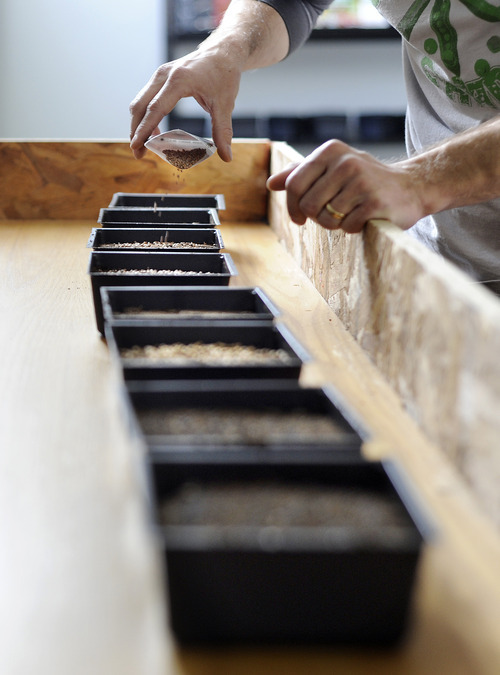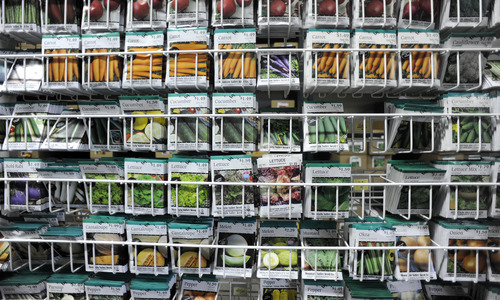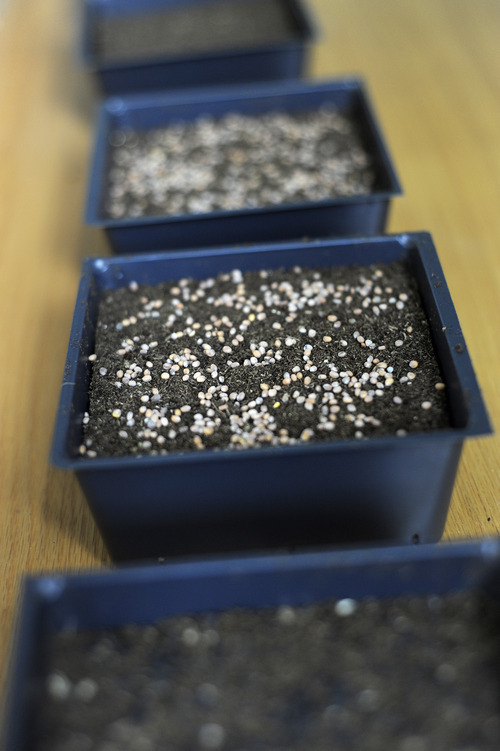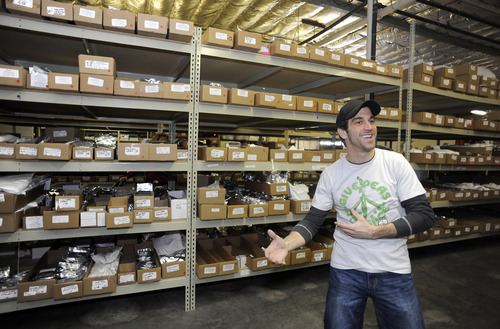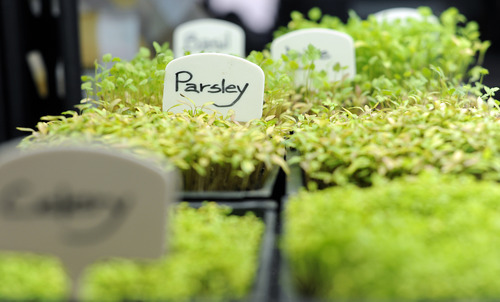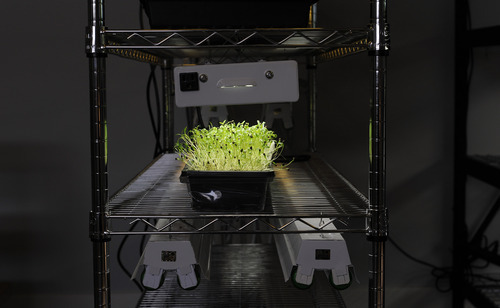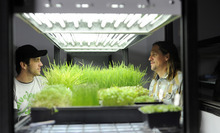This is an archived article that was published on sltrib.com in 2011, and information in the article may be outdated. It is provided only for personal research purposes and may not be reprinted.
The outside temperature is bitter cold and the ground is still frozen, yet Heather Lloyd and her family are enjoying the summertime flavors of fresh basil on a pizza and cilantro in a salad.
The source of this garden-fresh enjoyment — in mid-February, no less? A flat where the tender microgreens are growing in her Salt Lake City kitchen.
"I love how easy the microgreens are to incorporate into our meals year round," said the mother of two. "Just last night we were making individual pizzas and my 11-year-old went and cut some fresh basil to add to hers."
Microgreens — the whisper-thin stems and tender first leaves of lettuces, vegetables and herbs — have been the darlings of restaurant chefs in Utah and across the country for several years. But now Utah gardeners and home cooks have discovered these bold flavors, which are welcome any time of year, but especially during winter.
Lilliputian plants • Microgreens are possibly the smallest incarnation of a plant. They're grown in soil using regular garden seeds. Rather than letting the plants grow to full size, the stem and leaves are harvested when the plants are a week to 14 days old. (If they were allowed more time to grow, they would become "baby greens.")
Just about any garden plant can be grown for microgreens, including broccoli, beets, basil, cabbage, cilantro, parsley, onions, radishes, thyme and watercress.
Of course, some seeds are easier to grow than others, says Robb Baumann, of Mountain Valley Seed Co. in Salt Lake City. Baumann and co-owner Lance Heaton bought the 37-year-old seed company last year and recently moved the operation to a larger building at 455 W. 1700 South. The new location offers more storage for some of the 3,000 different seeds that the company carries, but it also includes a test room for growing microgreens.
"We think it's kind of fun to experiment with them," Baumann said. "But we also want to encourage people to grow year round and have fresh food even in the winter."
The company sells all the supplies that cooks need to start growing microgreens. It also offers a beginners kit for $18 that includes trays, soil, seeds and a cover. Baumann recommends the book Micrgreens: A guide to growing nutrient-packed greens, which was published by Utah-based Gibbs Smith, as it is what peaked his interest.
Mountain Valley also has joined forces with Sharon Leopardi, owner of BUG Farms, a local Community Supported Agriculture program. In the next few months, they'll team up to start experimenting with seeds, soils and lights to determine the best growing conditions for microgreens.
"Microgreens were really a big part of my business last year," Leopardi said. She sold them at the Downtown Farmers Market and to several Utah restaurants including Lugano, Pago, Forage and Stone Ground. She hopes by collaborating with Mountain Valley Seeds she can create even more excitement about one of her favorite foods.
"I eat them literally at every meal," she said, using them in place of lettuce on an egg salad sandwich; as a topper on soups; in salads and pastas; and even smoothies for extra nutrients.
Not sprouts •While there's quite a buzz about microgreens, cooks shouldn't confuse them with sprouts, says Mark Benson, a Salt Lake City chef and author of the Tenacious Palate website (http://tenaciouspalate.typepad.com.) Sprouts germinate in water — not soil — in the dark or in low light. Those conditions help the seed sprout quickly, but also makes them susceptible to bacteria such as E. coli.
Benson, a Utah native who attended culinary school in Las Vegas, said microgreens were a regular addition to foods at the Las Vegas restaurants where he worked, including Bradley Ogden Restaurant at Caesar's Palace .
"If there was cilantro in a dish, then we would use the cilantro microgreens as a garnish," he said. "Or if there was kohlrabi in a dish, we would use kohlrabi microgreens. At the restaurant level, microgreens are too expensive for salads or main dishes, and instead were employed sparingly to add color and interest to a dish.
Ian Brandt, the owner of Vertical Diner and Sage's Café, uses sunflower microgreens at his Salt Lake City restaurants. "They add height and air, and create a fresh element to a dish, especially one that has been heavily cooked like curry or stir-fry," he said.
Brandt buys his microgreens from Sunbridge Growers in Fairview. He also sells the microgreens at his Salt Lake City market, Cali's Natural Foods, 389 W. 1700 South.
Of course, growing your own microgreens makes them more economical, Lloyd said. "I do not have a green thumb and I can't believe how we have increased our 'green' consumption."
The short growing time of microgreens has sparked her children's interest in gardening and fresh foods. Lloyd added: "They get a thrill when they can take the scissors and give the plants a haircut."
—
More resources
Growing kits • For $18, microgreen growing kits are available at the Mountain Valley Seed Co. warehouse, 455 W. 1700 South, Salt Lake City, or online at mvseeds.com. The kit includes a trays, soil, seeds and a cover for growing four kinds of microgreens at one time.
Books • Micrgreens: A guide to growing nutrient-packed greens, by Eric Franks and Jasmine Richardson. (Gibbs Smith, $19.99)
Stores • Cali's Natural Foods, 389 W. 1700 South, Salt Lake City sells sunflower microgreens grown in Fairfield by Sunbridge Growers. One clamshell of microgreens costs $6. —
Deviled eggs with crab on mixed microgreens
6 eggs, hardboiled
1/3 cup extra-virgin olive oil, divided
1 teaspoon fresh lemon juice
Cayenne pepper
1 tablespoon parsley microgreens
1 tablespoon minced scallion
1 tablespoon small capers, rinsed
1/2 pound jumbo lump crabmeat
Salt
Pepper
1 tablespoon sherry vinegar
1/2 teaspoon Dijon mustard
5 cups mixed microgreens (such as arugula, spinach, cilantro etc.)
Remove the shells from the hardboiled eggs. Slice lengthwise. Carefully scoop egg yolks into bowl. Using a fork, mash yolks with 2 tablespoons olive oil, lemon juice and a generous pinch of cayenne pepper. Stir in the parsely microgreens, scallion and capers. Gently fold in crab. Season with salt and pepper. Generously mound the mixture into egg white halves.
In a large bowl, whisk vinegar, mustard and remaining olive oil. Season with salt and pepper. Add the mixed microgreens and toss to coat. Mound the greens on a plate and arrange deviled eggs on top. Garnish with capers.
Servings • 6
Source: Heather Lloyd —
Italian Manhattan with thyme microgreens
1 1/2 cups bourbon
1/2 cup Amaro liqueur (Italian herbal liqueur)
8 teaspoons orange blossom honey
4 teaspoons fresh lemon juice
8 fresh sprigs thyme microgreens
3 cups ice cubes
Combine bourbon, Amaro, honey, lemon juice and microgreens in pitcher; stir to blend. Mix in ice cubes. Divide mixture, including ice, among eight rocks glasses, making sure each cocktail has a sprig of the aromatic and colorful thyme.
Servings • 8
Source: Heather Lloyd —
Baby arugula, microgreens and roasted beet Salad with agave Dijon vinaigrette
Salad:
2 medium-sized golden beets, peeled
2 medium-sized red beets, peeled
4 ounces baby arugula
1/2 cup raw hazelnuts
1 package microgreens
1/4 cup dried tart cherries
Vinaigrette:
1 cup water
1/2 cup olive oil
1/4 cup apple cider vinegar
1/2 cup agave nectar
1/4 cup brown mustard seed
3 tablespoons lemon juice, fresh squeezed
2 teaspoons salt
Black pepper to taste
Heat oven to 375 degrees. Place beets on a baking tray and roast for 20 minutes or until cook all of the way through. Remove from oven and let the beets cool to room temperature. Then slice thin.
Toast raw hazelnuts in a sauté pan till the outside skin is lightly browned and easily removed. Remove from heat and cool until easy to handle. Remove skin and crush with an espresso grinder or a mortar and pestle.
For the vinaigrette, place all the ingredients in a blender. Blend until smooth, about 1 minute.
To serve, place baby arugula on plate, top with thinly sliced roasted beets. Drizzle with vinaigrette. Top with microgreens, toasted hazelnuts and dried cherries.
Season with salt and pepper.
Servings • 4
Source: Ian Brandt,owner Sage's Cafe, Vertical Diner and Cali's Natural Foods —
How to grow your own microgreens
1. Fill a seed tray about 3/4 full with nutrient soil made especially for seedlings.
2. Lightly compact the soil to create an even surface, but do not over compact.
3. Sprinkle a dense layer of seeds over the soil evenly.
4. Lightly press the soil, without pressing seed under the soil. This will help seeds take root.
5. Gently set a paper towel over the entire surface.
6. With a spray bottle, get the paper towel very wet.
7. Cover the tray with a plastic cover or plastic wrap to keep seeds warm and moist.
8. Water the soil every day to keep it moist. Remove the paper towel when the majority of seeds are up and have shed their hull.
9. Place in a sunny location or under a grow light. Once growth is established, you can remove cover.
10. To harvest, cut the microgreen stems with a sharp, clean pair of kitchen shears.
To see photos of the process, visit mvseeds.com/microgreens.html and download the Microgreen Quick Start Guide.
Source: Mountain Valley Seed Co.


